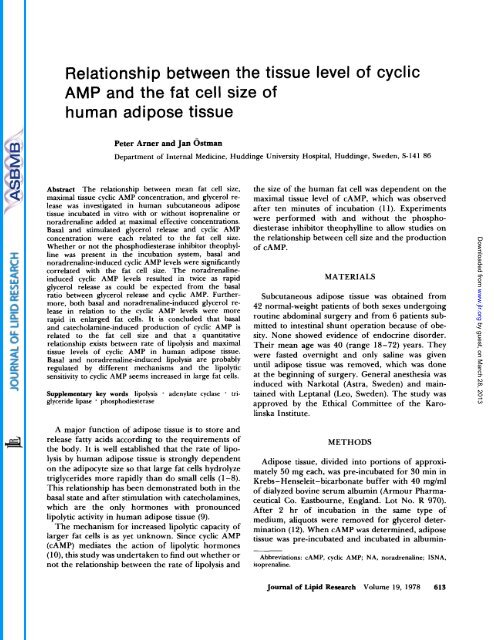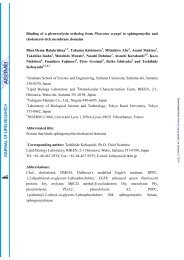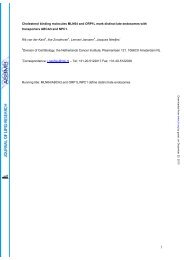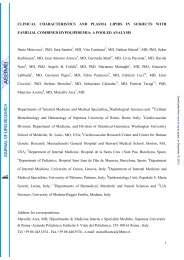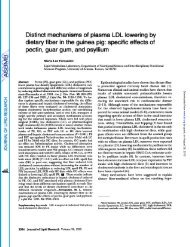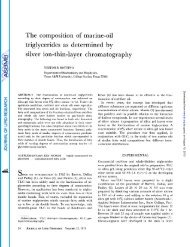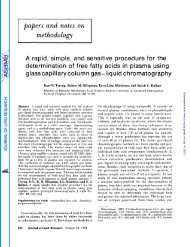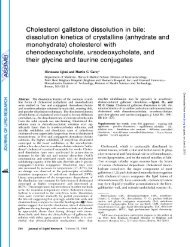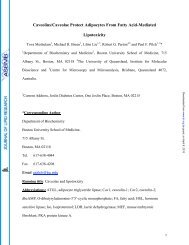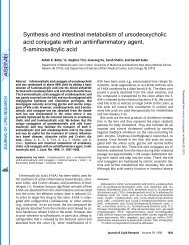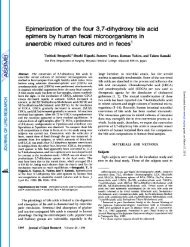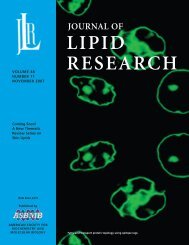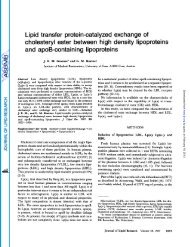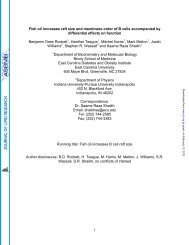Relationship between the tissue level of cyclic human adipose tissue
Relationship between the tissue level of cyclic human adipose tissue
Relationship between the tissue level of cyclic human adipose tissue
Create successful ePaper yourself
Turn your PDF publications into a flip-book with our unique Google optimized e-Paper software.
<strong>Relationship</strong> <strong>between</strong> <strong>the</strong> <strong>tissue</strong> <strong>level</strong> <strong>of</strong> <strong>cyclic</strong><br />
AMP and <strong>the</strong> fat cell size <strong>of</strong><br />
<strong>human</strong> <strong>adipose</strong> <strong>tissue</strong><br />
Peter Arner and Jan Ostman<br />
Department <strong>of</strong> Internal Medicine, Huddinge University Hospital, Huddinge, Sweden, S- 14 1 86<br />
Abstract The relationship <strong>between</strong> mean fat cell size,<br />
maximal <strong>tissue</strong> <strong>cyclic</strong> AMP concentration, and glycerol re-<br />
lease was investigated in <strong>human</strong> subcutaneous <strong>adipose</strong><br />
<strong>tissue</strong> incubated in vitro with or without isoprenaline or<br />
noradrenaline added at maximal effective concentrations.<br />
Basal and stimulated glycerol release and <strong>cyclic</strong> AMP<br />
concentration were each related to <strong>the</strong> fat cell size.<br />
Whe<strong>the</strong>r or not <strong>the</strong> phosphodiesterase inhibitor <strong>the</strong>ophyl-<br />
line was present in <strong>the</strong> incubation system, basal and<br />
noradrenaline-induced <strong>cyclic</strong> AMP <strong>level</strong>s were significantly<br />
correlated with <strong>the</strong> fat cell size. The noradrenaline-<br />
induced <strong>cyclic</strong> AMP <strong>level</strong>s resulted in twice as rapid<br />
glycerol release as could be expected from <strong>the</strong> basal<br />
ratio <strong>between</strong> glycerol release and <strong>cyclic</strong> AMP. Fur<strong>the</strong>r-<br />
more, both basal and noradrenaline-induced glycerol re-<br />
lease in relation to <strong>the</strong> <strong>cyclic</strong> AMP <strong>level</strong>s were more<br />
rapid in enlarged fat cells. It is concluded that basal<br />
and catecholamine-induced production <strong>of</strong> <strong>cyclic</strong> AMP is<br />
related to <strong>the</strong> fat cell size and that a quantitative<br />
relationship exists <strong>between</strong> rate <strong>of</strong> lipolysis and maximal<br />
<strong>tissue</strong> <strong>level</strong>s <strong>of</strong> <strong>cyclic</strong> AMP in <strong>human</strong> <strong>adipose</strong> <strong>tissue</strong>.<br />
Basal and noradrenaline-induced lipolysis are probably<br />
regulated by different mechanisms and <strong>the</strong> lipolytic<br />
sensitivity to <strong>cyclic</strong> AMP seems increased in large fat cells.<br />
Supplementary key words lipolysis * adenylate cyclase * tri-<br />
glyceride lipase * phosphodiesterase<br />
A major function <strong>of</strong> <strong>adipose</strong> <strong>tissue</strong> is to store and<br />
release fatty acids according to <strong>the</strong> requirements <strong>of</strong><br />
<strong>the</strong> body. It is well established that <strong>the</strong> rate <strong>of</strong> lipo-<br />
lysis by <strong>human</strong> <strong>adipose</strong> <strong>tissue</strong> is strongly dependent<br />
on <strong>the</strong> adipocyte size so that large fat cells hydrolyze<br />
triglycerides more rapidly than do small cells (1-8).<br />
This relationship has been demonstrated both in <strong>the</strong><br />
basal state and after stimulation with catecholamines,<br />
which are <strong>the</strong> only hormones with pronounced<br />
lipolytic activity in <strong>human</strong> <strong>adipose</strong> <strong>tissue</strong> (9).<br />
The mechanism for increased lipolytic capacity <strong>of</strong><br />
larger €at cells is as yet unknown. Since <strong>cyclic</strong> AMP<br />
(CAMP) mediates <strong>the</strong> action <strong>of</strong> lipolytic hormones<br />
(lo), this study was undertaken to find out whe<strong>the</strong>r or<br />
not <strong>the</strong> relationship <strong>between</strong> <strong>the</strong> rate <strong>of</strong> lipolysis and<br />
<strong>the</strong> size <strong>of</strong> <strong>the</strong> <strong>human</strong> fat cell was dependent on <strong>the</strong><br />
maximal <strong>tissue</strong> <strong>level</strong> <strong>of</strong> CAMP, which was observed<br />
after ten minutes <strong>of</strong> incubation (1 1). Experiments<br />
were performed with and without <strong>the</strong> phospho-<br />
diesterase inhibitor <strong>the</strong>ophylline to allow studies on<br />
<strong>the</strong> relationship <strong>between</strong> cell size and <strong>the</strong> production<br />
<strong>of</strong> CAMP.<br />
MATERIALS<br />
Subcutaneous <strong>adipose</strong> <strong>tissue</strong> was obtained from<br />
42 normal-weight patients <strong>of</strong> both sexes undergoing<br />
routine abdominal surgery and from 6 patients sub-<br />
mitted to intestinal shunt operation because <strong>of</strong> obe-<br />
sity. None showed evidence <strong>of</strong> endocrine disorder.<br />
Their mean age was 40 (range 18-72) years. They<br />
were fasted overnight and only saline was given<br />
until <strong>adipose</strong> <strong>tissue</strong> was removed, which was done<br />
at <strong>the</strong> beginning <strong>of</strong> surgery. General anes<strong>the</strong>sia was<br />
induced with Narkotal (Astra, Sweden) and main-<br />
tained with Leptanal (Leo, Sweden). The study was<br />
approved by <strong>the</strong> Ethical Committee <strong>of</strong> <strong>the</strong> Karo-<br />
linska Institute.<br />
METHODS<br />
Adipose <strong>tissue</strong>, divided into portions <strong>of</strong> approxi-<br />
mately 50 mg each, was pre-incubated for 30 min in<br />
Krebs-Henseleit-bicarbonate buffer with 40 mg/ml<br />
<strong>of</strong> dialyzed bovine serum albumin (Armour Pharma-<br />
ceutical Co. Eastbourne, England. Lot No. R 970).<br />
After 2 hr <strong>of</strong> incubation in <strong>the</strong> same type <strong>of</strong><br />
medium, aliquots were removed for glycerol deter-<br />
mination (12). When CAMP was determined, <strong>adipose</strong><br />
<strong>tissue</strong> was pre-incubated and incubated in albumin-<br />
Abbreviations: CAMP, <strong>cyclic</strong> AMP; NA, noradrenaline; ISNA,<br />
isoprenaline.<br />
Journal <strong>of</strong> Lipid Research Volume 19, 1978 613<br />
Downloaded from<br />
www.jlr.org<br />
by guest, on March 28, 2013
Glycerol, pmol / IO' cells<br />
Basal<br />
15.<br />
10.<br />
r : 0 003<br />
n= 38<br />
p< 0 001<br />
y: 0 mx - 19<br />
Glycerol. pmol I IO' cells<br />
6x10'' mol / I <strong>of</strong> ISNA<br />
601 r = 0.696<br />
n.23<br />
20<br />
y = 0 04x - 4 6<br />
0 500<br />
07<br />
0 500 1000 0 500<br />
Fig. 1.<br />
.<br />
Fat cell volume, "?.IO-'<br />
<strong>tissue</strong> was incubated for 2 hr in <strong>the</strong> presence or absence <strong>of</strong> 6 X<br />
noradrenaline (NA). n = 3-5 in <strong>the</strong> individual experiments.<br />
Glycerol, ,uno1 /IO' cells<br />
6.10.' moll I <strong>of</strong> NA<br />
30.<br />
r = 0 741<br />
<strong>Relationship</strong> <strong>between</strong> mean fat cell volume and glycerol release. Human subcutaneous <strong>adipose</strong><br />
mom <strong>of</strong> isoprenaline (ISNA) or<br />
free buffer, since albumin interferes with <strong>the</strong> cAMP<br />
assay (13). Unless o<strong>the</strong>rwise stated, 10 mmoVl <strong>of</strong><br />
<strong>the</strong>ophylline (ACO, Sweden) was added to <strong>the</strong> buffer<br />
solutions in <strong>the</strong> cAMP experiments to inhibit phos-<br />
phodiesterase. After 10 min <strong>of</strong> incubation, when <strong>the</strong><br />
hormone-induced peak <strong>tissue</strong> <strong>level</strong> <strong>of</strong> CAMP is known<br />
to occur (11), <strong>adipose</strong> <strong>tissue</strong> was removed for<br />
determination <strong>of</strong> cAMP by a modification (1 3) <strong>of</strong> <strong>the</strong><br />
protein-binding method <strong>of</strong> Gilman (14). Nor-<br />
adrenaline bitartrate (Astra, Sweden) and isopropyl-<br />
noradrenaline-HC1 (Winthrop, England) were added<br />
in vitro. Both agents were dissolved in <strong>the</strong> medium<br />
to give a final concentration <strong>of</strong> 6 X lo-' moV1, known<br />
to induce maximal stimulation <strong>of</strong> <strong>the</strong> rate <strong>of</strong> lipo-<br />
lysis and cAMP production (1 1, 15). Fur<strong>the</strong>r details<br />
have been described elsewhere (16).<br />
The fat cell diameter was determined by <strong>the</strong><br />
method <strong>of</strong> Sjostrom, Bjorntorp, and VrPna (17).<br />
One hundred cells were measured and <strong>the</strong> mean<br />
cellular content was calculated according to <strong>the</strong><br />
method <strong>of</strong> Hirsch and Gallian (18). The fat cell<br />
number was calculated from <strong>the</strong> mean cellular<br />
triglyceride weight and <strong>the</strong> total triglyceride content<br />
<strong>of</strong> <strong>the</strong> fat portions. Statistical analyses were per-<br />
formed according to those described by Snedecor and<br />
Cochran (19).<br />
RESULTS<br />
The rate <strong>of</strong> glycerol release was a linear function<br />
<strong>of</strong> <strong>the</strong> mean fat cell size (Fig. 1) when <strong>adipose</strong><br />
<strong>tissue</strong> was incubated under basal conditions or in <strong>the</strong><br />
614 Journal <strong>of</strong> Lipid Research Volume 19, 1978<br />
presence <strong>of</strong> noradrenaline (NA) or isoprenaline<br />
(ISNA). No influence <strong>of</strong> age and sex was observed.<br />
It is seen in Fig. 2 that whe<strong>the</strong>r <strong>adipose</strong> <strong>tissue</strong><br />
was incubated in basal medium (r = +0.67, P<br />
< 0.001) or in <strong>the</strong> presence <strong>of</strong> NA (r = +0.58,<br />
P < 0.01), <strong>the</strong> maximal <strong>tissue</strong> <strong>level</strong> <strong>of</strong> cAMP was<br />
significantly correlated with <strong>the</strong> fat cell size. Also <strong>the</strong><br />
ISNA-induced cAMP <strong>level</strong> was significantly correlated<br />
with <strong>the</strong> cell size (r = +0.60, P < 0.001).<br />
Fig. 3 shows <strong>the</strong> effect <strong>of</strong> <strong>the</strong>ophylline on cAMP<br />
in <strong>adipose</strong> <strong>tissue</strong> incubated under basal conditions.<br />
The cAMP <strong>level</strong> was cell-size dependent whe<strong>the</strong>r<br />
<strong>adipose</strong> <strong>tissue</strong> was incubated in <strong>the</strong> presence <strong>of</strong><br />
<strong>the</strong>ophylline (r = +0.82, P < 0.001) or not (r<br />
= +0.64, P < 0.01). The net increase <strong>of</strong> cAMP due to<br />
<strong>the</strong>ophylline was also significantly related to <strong>the</strong> fat<br />
cell size (r = +0.77, P < 0.001). Fig. 4 shows that<br />
similar results were obtained for <strong>the</strong> effect <strong>of</strong> <strong>the</strong>o-<br />
phylline on <strong>the</strong> NA-induced cAMP <strong>level</strong>s (r = +0.89,<br />
P < 0.01 with <strong>the</strong>ophylline; r = +0.92, P < 0.01 with-<br />
out <strong>the</strong>ophylline; and r = +0.84, P < 0.01 for net<br />
increasing effect <strong>of</strong> <strong>the</strong>ophylline), but not on <strong>the</strong><br />
ISNA-induced cAMP concentration (uncharted ex-<br />
periments). It is seen in Figs. 3 and 4, that <strong>the</strong><br />
slopes <strong>of</strong> <strong>the</strong> regression lines for cAMP vs. fat cell<br />
size in <strong>the</strong> NA experiments are almost identical with<br />
those obtained under basal conditions, whe<strong>the</strong>r <strong>the</strong>o-<br />
phylline was present or not. On <strong>the</strong> o<strong>the</strong>r hand, <strong>the</strong><br />
intercepts were more positive in <strong>the</strong> NA experiments.<br />
In order to elucidate <strong>the</strong> lipolytic response to <strong>the</strong><br />
<strong>cyclic</strong> AMP <strong>level</strong> <strong>of</strong> a given size <strong>of</strong> fat cell, we<br />
have in Fig. 5 used <strong>the</strong> data <strong>of</strong> Figs. 1, 3, and 4,<br />
and <strong>the</strong>n calculated <strong>the</strong> ratio <strong>between</strong> <strong>the</strong> glycerol<br />
Downloaded from<br />
www.jlr.org<br />
by guest, on March 28, 2013
I 3000<br />
1000 ..<br />
CAMP. pma / IO' cells<br />
Basal<br />
r = 0669<br />
I n=36<br />
I<br />
/...; .. ..<br />
0 1<br />
0 500 IOW<br />
0<br />
CAMP, pmol I m' cells<br />
6 n 10. mol I I <strong>of</strong> ISNA<br />
r.0601 .<br />
yZ19r - 10<br />
'<br />
5w lay)<br />
1ooO-<br />
500-<br />
3OW.<br />
2000.<br />
NMO.<br />
CAW, ~"OI / 10'cells<br />
6.10~'molII <strong>of</strong> NA<br />
r.0583<br />
n= 23<br />
O
CAM? pmol/ IO' ceIIs<br />
with <strong>the</strong>ophylline<br />
2ooC<br />
ISM)<br />
I om<br />
5M)<br />
0<br />
.<br />
CAMP, pmol I IO' cells<br />
wilhout <strong>the</strong>ophylline<br />
500<br />
4M)<br />
300<br />
m<br />
rZO888<br />
n: 8 100<br />
p
<strong>tissue</strong> was incubated in <strong>the</strong> presence <strong>of</strong> a maximally<br />
effective concentration <strong>of</strong> ISNA (Fig. 1). This indi-<br />
cates that <strong>the</strong> maximal capacity <strong>of</strong> both triglyceride<br />
lipase and adenylate cyclase is increased in large fat<br />
cells in agreement with our previous findings (21).<br />
The interrelationship <strong>between</strong> lipolytic effect, cAMP<br />
concentration, and fat cell size supports a previous<br />
investigation where indirect evidence was given for<br />
a positive correlation <strong>between</strong> ISNA-induced cAMP<br />
<strong>level</strong> and fat cell size (1 1).<br />
When Figs. 1 and 2 are compared, it is observed<br />
that ISNA is about twice as potent a stimulator <strong>of</strong> <strong>the</strong><br />
rate <strong>of</strong> lipolysis as NA, whereas <strong>the</strong> effect <strong>of</strong> ISNA<br />
on cAMP production is approximately ten times as<br />
great as that <strong>of</strong> NA. This is in agreement with our<br />
previous observation (1 1) showing a semilogarithmic<br />
relationship <strong>between</strong> lipolysis (linear) and cAMP <strong>level</strong>s<br />
(log) in <strong>human</strong> <strong>adipose</strong> <strong>tissue</strong> incubated with ISNA.<br />
It is reported that no correlation exists <strong>between</strong> <strong>the</strong><br />
rate <strong>of</strong> hormone-induced lipolysis and <strong>the</strong> <strong>level</strong> <strong>of</strong><br />
cAMP <strong>of</strong> <strong>the</strong> rat adipocyte (22), whereas <strong>the</strong> present<br />
investigation speaks for a quantitative relationship<br />
<strong>between</strong> rate <strong>of</strong> lipolysis and maximal cAMP concen-<br />
trations in <strong>human</strong> fat cells. The difference <strong>between</strong><br />
our results and previous findings (22) could be ex-<br />
plained ei<strong>the</strong>r by species differences or by <strong>the</strong> fact<br />
that we used intact <strong>adipose</strong> <strong>tissue</strong>, unlike most <strong>of</strong> <strong>the</strong><br />
previous investigators who used isolated adipocytes.<br />
Although <strong>the</strong> experimental conditions for <strong>the</strong> cAMP<br />
and <strong>the</strong> glycerol experiments differed, some general<br />
information could be obtained from <strong>the</strong> results re-<br />
corded in Fig. 5. First, about twice as much glycerol<br />
was produced per unit <strong>of</strong> cAMP when <strong>adipose</strong> <strong>tissue</strong><br />
was incubated with NA in comparison with <strong>the</strong> basal<br />
state. This was true for small and for large fat cells<br />
and indicates that different mechanisms exist for basal<br />
and hormonal activation <strong>of</strong> lipolysis. Second, <strong>the</strong><br />
exchange <strong>of</strong> glycerol produced per unit <strong>of</strong> <strong>tissue</strong> cAMP<br />
increased as <strong>the</strong> fat-cell volume increased. This was<br />
observed for both basal and NA-induced lipolysis<br />
and suggests that triglyceride lipase is more readily<br />
activated by cAMP when fat cells are enlarged. This<br />
conclusion is fur<strong>the</strong>r supported by <strong>the</strong> comparison<br />
<strong>of</strong> <strong>the</strong> regression lines for basal and <strong>the</strong> NA experi-<br />
ments in Figs. 1,3, and 4. In <strong>the</strong> absence <strong>of</strong> <strong>the</strong>ophyl-<br />
line (center panels in Figs. 3 and 4) or in <strong>the</strong> presence<br />
<strong>of</strong> <strong>the</strong> phosphodiesterase inhibitor (left panels in Figs.<br />
3 and 4) NA affects only <strong>the</strong> intercepts <strong>of</strong> <strong>the</strong> regression<br />
lines, showing that <strong>the</strong> net effect <strong>of</strong> NA on cAMP<br />
production is <strong>of</strong> <strong>the</strong> same order <strong>of</strong> magnitude in small<br />
and large fat cells. In <strong>the</strong> lipolysis experiments, how-<br />
ever, shown in <strong>the</strong> left and right panels <strong>of</strong> Fig. l,<br />
NA increased both <strong>the</strong> slope and <strong>the</strong> intercept <strong>of</strong> <strong>the</strong><br />
regression curve. Thus, <strong>the</strong> net lipolytic effect <strong>of</strong> NA<br />
was more pronounced in larger fat cells.<br />
Several reports have suggested that <strong>the</strong> hormone-<br />
induced cAMP <strong>level</strong> would represent an unphysiologi-<br />
cal overproduction <strong>of</strong> CAMP in <strong>adipose</strong> <strong>tissue</strong> (23-29)<br />
and that cAMP is sequestered into different compart-<br />
ments with only a small pool being responsible for<br />
<strong>the</strong> transmission <strong>of</strong> <strong>the</strong> hormonal effect (25, 26, 30-<br />
33). Our results are in contrast to those ideas, since<br />
<strong>the</strong> correlations <strong>between</strong> cAMP and lipolysis on <strong>the</strong><br />
one hand and fat cell size on <strong>the</strong> o<strong>the</strong>r hand were<br />
observed both when <strong>the</strong> phosphodiesterase inhibitor<br />
<strong>the</strong>ophylline was added and when it was omitted in<br />
<strong>the</strong> experiments with CAMP. Thus, cAMP seems to be<br />
produced and degraded in physiological amounts<br />
corresponding to <strong>the</strong> requirement for activating lipoly-<br />
sis by <strong>human</strong> adipocytes. Fur<strong>the</strong>rmore, <strong>the</strong> catechola-<br />
mine-induced cAMP <strong>level</strong> <strong>of</strong> <strong>human</strong> <strong>adipose</strong> <strong>tissue</strong><br />
very probably represents a single compartment <strong>of</strong> <strong>the</strong><br />
nucleotide, as we have suggested earlier (1 l).m<br />
This investigation was supported by grants from <strong>the</strong> Swed-<br />
ish Medical Research Council, Swedish Diabetic Associa-<br />
tion, and <strong>the</strong> Loo and Hans Osterman Fund. We thank<br />
Mrs. Raija Jonsson and Mrs. Else-Britt Lundstrom for <strong>the</strong>ir<br />
excellent technical assistance.<br />
Manuscript received 29 Apll 1977 and in revised form 6 September<br />
1977; accepted 24 January 1978.<br />
1.<br />
2.<br />
3.<br />
4.<br />
5.<br />
6.<br />
7.<br />
8.<br />
REFERENCES<br />
Faulhaber, J. D., E. N. Petruzzi, H. Eble, and H. Ditschuneit.<br />
1969. In vitro Untersuchungen uber den<br />
Fettst<strong>of</strong>fwechsel isolierter menschlischer Fettzellen in<br />
Abhangigkeit von der Zellgrosse: Die durch Adrenalin<br />
induzierte Lipolyse. Horm. Metab. Res. 1: 80-86.<br />
Goldrick, R. B., and G. M. McLoughlin. 1970. Lipolysis<br />
and lipogenesis from glucose in <strong>human</strong> fat cells <strong>of</strong> different<br />
sizes. J. Clin. Invest. 49: 1213-1223.<br />
Gries, F. A., M. Berger, M. Neumann, H. Preiss, H.<br />
Liebermeister, C. Hesse-Wortmann, and K. Jahnke.<br />
1972. Effects <strong>of</strong> norepinephrine, <strong>the</strong>ophylline and<br />
dibuturyl <strong>cyclic</strong> AMP on in vitro lipolysis <strong>of</strong> <strong>human</strong><br />
<strong>adipose</strong> <strong>tissue</strong> in obesity. Diabetologia 8: 75-83.<br />
Jacobson, B., and U. Smith. 1972. Effect <strong>of</strong> cell size<br />
on lipolysis and antilipolytic action <strong>of</strong> insulin in <strong>human</strong><br />
fat cel1s.J. Lzpid. Res. 13: 651-656.<br />
Knittle, J. L., and F. Ginsberg-Fellner. 1972. Effect<br />
<strong>of</strong> weight reduction on in vitro <strong>adipose</strong> <strong>tissue</strong> lipolysis<br />
and cellularity in obese adolescents and adults. Diabetes<br />
21: 754-766.<br />
Lisch, H.-J., S. Sailer, F. Sandh<strong>of</strong>er, and H. Braunsteiner.<br />
1970. Untersuchungen an isolierten menschlichen<br />
Fettzellen verschiedner Fettgewebsregionen. 11.<br />
Beziehungen zwischen Zellvoiumen und basaler Lipol-<br />
se Klan. Wochemchr 22: 1353-1356.<br />
imith, U. 1970. Effect <strong>of</strong> glucose and insulin on lipoly-<br />
sis rates in <strong>human</strong> fat cells <strong>of</strong> different sizes. FEBS<br />
Lett. 11: 8-10.<br />
Ostman, J., L. Backman, and D. Hallberg. 1975. Cell<br />
size and <strong>the</strong> antilipolytic effect <strong>of</strong> insulin in <strong>human</strong><br />
subcutaneous <strong>adipose</strong> <strong>tissue</strong>. Diubetologia 11: 159- 164.<br />
Arner and Ostmun <strong>Relationship</strong> <strong>between</strong> <strong>cyclic</strong> AMP and fat cell size 617<br />
Downloaded from<br />
www.jlr.org<br />
by guest, on March 28, 2013
9. Bjorntorp, P., and J. Ostman. 1971. Human <strong>adipose</strong><br />
<strong>tissue</strong>. Dynamics and regulations. In Advances in Metabolic<br />
Disorders. Vol. 5. R. Levine and R. Luft, editors.<br />
Academic Press, New York and London 277-327.<br />
10. Robinson, G. A., R. W. Butcher, and E. W. Su<strong>the</strong>rland.<br />
1971. Lipolysis in <strong>adipose</strong> <strong>tissue</strong>. In Cyclic AMP. G. A.<br />
Robinson and E. W. Su<strong>the</strong>rland, editors. Academic<br />
Press, New York. 286-320.<br />
11. Arner, P. 1976. <strong>Relationship</strong> <strong>between</strong> intracellular<br />
<strong>cyclic</strong> AMP and lipolysis in <strong>human</strong> <strong>adipose</strong> <strong>tissue</strong>. Acta<br />
Med. Scand. 200: 179-186.<br />
12. Chernick, S. S. 1969. Determination <strong>of</strong> glycerol in acyl<br />
glycerols. In Methods in Enzymology. Vol. 4, Lipids.<br />
J. M. Loewenstein, editor. Academic Press, New York<br />
and London. 627.<br />
13. Arner, P., and J. Ostman. 1975. Methodological aspects<br />
<strong>of</strong> protein-binding assays for <strong>cyclic</strong> AMP in <strong>human</strong><br />
<strong>adipose</strong> <strong>tissue</strong>. Scand. J. Clin. Lab. Invest. 35: 691-697.<br />
14. Gilman, A. G. 1970. A protein binding assay for adenosine<br />
3',5'-<strong>cyclic</strong> monophosphate. Proc. Nut. Acad. Sci.<br />
(Wmh.) 67: 305-312.<br />
15. Ostman, J., S. Efendik, and P. Arner. 1969. Catecholamines<br />
and metabolism <strong>of</strong> <strong>human</strong> <strong>adipose</strong> <strong>tissue</strong>. I.<br />
Comparison <strong>between</strong> in vitro effects <strong>of</strong> noradrenaline,<br />
adrenaline, and <strong>the</strong>ophylline on lipolysis in omental<br />
<strong>adipose</strong> <strong>tissue</strong>. Acta Med. Scand. 186: 241-246.<br />
16. Ostman, J. 1965. A procedure for in vitro studies on<br />
fatty acid metabolism by <strong>human</strong> subcutaneous <strong>adipose</strong><br />
<strong>tissue</strong>. Acta Med. Scand. 177: 183- 197.<br />
17. Sjostrom, L., P. Bjorntorp, and J. Vrana. 1971. Microscopic<br />
fat cell size measurements on frozen-cut <strong>adipose</strong><br />
<strong>tissue</strong> in comparison with automatic determination <strong>of</strong><br />
osmium-fixed fat cells. J. Lzpid. Res. 12: 521-530.<br />
18. Hirsch, J., and E. Gallian. 1968. Methods for <strong>the</strong> determination<br />
<strong>of</strong> <strong>adipose</strong> cell size and cell number in man<br />
and animals.]. Lipid Res. 9: 110- 119.<br />
19. Snedecor, G. W., and W. G. Cochran. 1971. Statistical<br />
Methods. The Iowa State University Press, Iowa. 1-593.<br />
20. Jacobson, B., G. Holm, P. Bjorntorp, and U. Smith.<br />
1976. Influence <strong>of</strong> cell size on <strong>the</strong> effects <strong>of</strong> insulin<br />
and noradrenaline on <strong>human</strong> <strong>adipose</strong> <strong>tissue</strong>. Diabetologia.<br />
12: 69-72.<br />
21. Ostman, J., L. Backman, and D. Hallberg. 1973. Cell<br />
size and lipolysis by <strong>human</strong> subcutaneous <strong>adipose</strong> <strong>tissue</strong>.<br />
Acta Med. Scand. 193: 469-475.<br />
22. Fain, J. N. 1973. Biochemical aspects <strong>of</strong> drug and hormone<br />
action on <strong>adipose</strong> <strong>tissue</strong>. Phannacol. Rev. 25:<br />
67-1 18.<br />
618 Journal <strong>of</strong> Lipid Research Volume 19, 1978<br />
23. Butcher, R. W., and C. E. Baird. 1969. The regulation<br />
<strong>of</strong> <strong>cyclic</strong> AMP and lipolysis in <strong>adipose</strong> <strong>tissue</strong> by hor-<br />
mones and o<strong>the</strong>r agents. Adv. Exp. Med. Biol. 4: 5-24.<br />
24. Butcher, R. W., C. E. Baird, and E. W. Su<strong>the</strong>rland.<br />
1968. Effects <strong>of</strong> lipolytic and antilipolytic substances<br />
on adenosine 3',5'-monophosphate <strong>level</strong>s in isolated<br />
fat cel1s.J. Biol. Chem. 243: 1705-1712.<br />
25. Butcher, R. W., J. G. T. Sneyd, C. R. Park, and E. W.<br />
Su<strong>the</strong>rland. 1966. Effect <strong>of</strong> insulin on adenosine 3',5'-<br />
monophosphate in <strong>the</strong> rat epididymal fat pad. J. Biol.<br />
Chem. 241: 1651-1653.<br />
26. Fain, J. N., R. H. Pointer, and W. F. Ward. 1972. Effects<br />
<strong>of</strong> adenosine nucleosides on adenyl cyclase phospho-<br />
diesterase, <strong>cyclic</strong> adenosine monophosphate accumula-<br />
tion, and lipolysis in fat cells. J. Biol. Chem. 247: 6866-<br />
6872.<br />
27. Schwabe, U., and R. Ebert. 1972. Different effects <strong>of</strong><br />
lipolytic hormones and phosphodiesterase inhibitors on<br />
<strong>cyclic</strong> 3',5'-AMP <strong>level</strong>s in isolated fat cells. Naunyn-<br />
Schmiedeberg's Arch. Pharmacol. 274: 287-298.<br />
28. Schwabe, U., and R. Ebert. 1974. Stimulation <strong>of</strong> <strong>cyclic</strong><br />
adenosine 3',5'-monophosphate accumulation and<br />
lipolysis in fat cells by adenosine deaminase. Naunyn-<br />
Schmiedeberg's Arch. Pharmacol. 282: 33-44.<br />
29. Stock, K., and M. Prilop. 1974. Dissociation <strong>of</strong> catechol-<br />
amine-induced formation <strong>of</strong> adenosine 3',5'-mono-<br />
phosphate and release <strong>of</strong> glycerol in fat cells by prosta-<br />
glandin E,, E2 and Ne-phenylisopropyladenosine.<br />
Naunyn-Schmiedeberg's Arch. Phannacol. 292: 15-3 1.<br />
30. Kono, T., and F. W. Barham. 1973. Effects <strong>of</strong> insulin<br />
on <strong>the</strong> <strong>level</strong>s <strong>of</strong> adenosine 3',5'-monophosphate and<br />
lipolysis in isolated rat epididymal fat cells. J. Biol. Chem.<br />
248: 7417-7426.<br />
31. Krug, F., J. Parikh, G. Illiano, and P. Cuatrecasas. 1973.<br />
Alpha, beta-methylene-adenosine 5'-triphosphate-<br />
effects <strong>of</strong> a competitive inhibitor <strong>of</strong> adenylate cyclase<br />
on <strong>cyclic</strong> AMP accumulation and lipolysis in isolated<br />
fat cells. Biochem. Biophys. Res. Comm. 50: 985-991.<br />
32. Kuo, J. F., and E. C. De Renzo. 1969. A comparison<br />
<strong>of</strong> <strong>the</strong> effects <strong>of</strong> lipolytic and antilipolytic agents on<br />
adenosine 3',5'-monophosphate <strong>level</strong>s in <strong>adipose</strong> cells<br />
as determined by prior labelling with adenosine-8-14C.<br />
J. Biol. Chem. 244: 2252-2260.<br />
33. Siddle, K., and C. N. Hales. 1974. The relationship<br />
<strong>between</strong> <strong>the</strong> concentration <strong>of</strong> adenosine 3',5'-<strong>cyclic</strong><br />
monophosphate and <strong>the</strong> anti-lipolytic action <strong>of</strong> insulin<br />
in isolated rat fat-cells. Biochem. J. 142: 97-103.<br />
Downloaded from<br />
www.jlr.org<br />
by guest, on March 28, 2013


